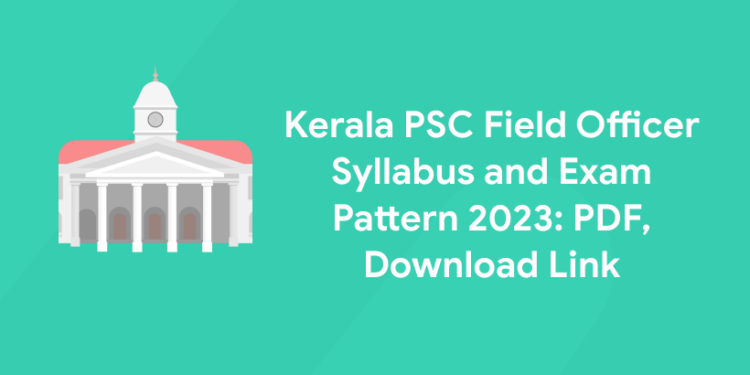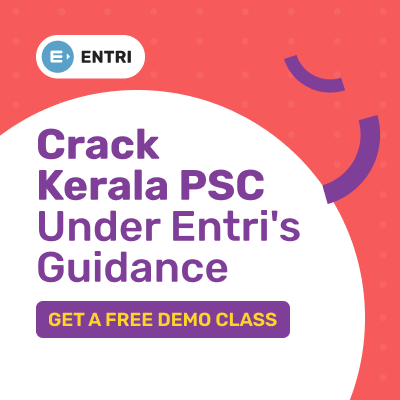Table of Contents
Kerala Public Service Commission has published Field Officer, Category Number 321/2022, Syllabus 2023 with Exam Pattern in PDF format. The syllabus is now available on the official website. The Kerala PSC Field Officer exam pattern will assure overall coverage of the questions that will appear in the exam, allowing you to plan the study strategy accordingly. Eligible candidates should check the KPSC Field Officer Syllabus as soon as possible. For your convenience, we have provided the Syllabus PDF here. See Kerala PSC Field Officer Exam Pattern and Syllabus PDF below.
Join Our Kerala PSC Telegram Channel for Latest Updates
Kerala PSC Field Officer Exam Paattern and Syllabus 2023: Highlights
| Particulars | Details |
| Name of recruiting organization | Kerala Public Service Commission (PSC) |
| Name of department | Various |
| Name of post | Field Officer |
| Number of vacancies | As per Notification |
| Tpe of Exam | OMR |
| Number of Questions | 100 |
| Total Marks | 100 |
| Medium of Questions | Malayalam/ Kannada/ Tamil |
| Mode of application | Online |
| Mode of recruitment | Direct Recruitment |
| Exam Duration | 1 hour 15 Minitues |
| Official Webiste | www.keralapsc.gov.in |
Kerala PSC Field Officer Selection Process 2023
1: Which Year First Assembly Election was held in Kerala?
The selection method for Kerala PSC Field Officer Recruitment 2023 includes:
- Prelims
- Mains
- Document Verification
- Personal Interview
Kerala PSC Field Officer Exam Pattern 2023
| Subjects | Mark Distribution |
| General Knowledge | 10 |
| General English | 10 |
| Physics | 14 |
| Chemistry | 14 |
| Botony | 14 |
| Zoology | 14 |
| Mathematics | 14 |
| Regional Language (Malayalam/Tamil/Kannada) | 10 |
Kerala PSC Field Officer Syllabus 2023
PART – I
General Knowledge
- Facts about India: Geography of India – Physical features – Climate – Soils – Rivers – Famous sites – etc.
Demography – Economic and social development – Poverty alleviation – Economy and
planning – etc. - History of India – Period from 1857 to 1947 – National movement
- Five Year Plans
- Facts about Kerala
- Geographical Facts – Physical features – Climate – Soils – Rivers – Famous sites – Economic and Social deve – Historical importance – etc.
- Renaissance in Kerala: Important Events/Movements/Leaders
- Brahmananda Swami Sivayogi, Chattampi Swami, Sree Narayana Guru, Vagbhatananda, Thycaud Ayya, Ayya Vaikundar, Poikayil Yohannan (Kumara Guru), Ayyankali, Pandit Karuppan, Mannathu Padmanabhan,V. T. Bhattathirippad, Dr. Palpu, Kumaranasan, Vakkom Moulavi, Blessed Kuriakose Elias Chavara, Etc.
- Current Affairs
- Important world, national and regional events related to the political and scientific fields, sports, cinema and literature etc.
GENERAL ENGLISH (10 Marks)
English Grammar (5 Marks)
- Types of Sentences and Interchange of Sentences.
- Different Parts of Speech.
- Agreement of Subject and Verb.
- Articles – Definite and Indefinite Articles.
- Uses of Primary and Modal Auxiliary Verbs
- Question Tags
- Infinitive and Gerunds
- Tenses
- Tenses in Conditional Sentences
- Prepositions
- The Use of Correlatives
- Direct and Indirect Speech
- Active and Passive voice
- Correction of Sentences
- Degrees of Comparison
Vocabulary (5 Marks)
- Singular & Plural, Change of Gender, Collective Nouns
- Word formation from other words and use of prefix or suffix
- Compound words
- Synonyms
- Antonyms
- Phrasal Verbs
- Foreign Words and Phrases
- One Word Substitutes
- Words often confused
- Spelling Test
- Idioms and their Meanings
- Expansion and meaning of Common Abbreviations
PART – III Physics ( 14 Marks)
Module 1. Properties of Matter (4 marks)
- ElasticityModulus of elasticity, the three elastic modulii, Surface tensionshapes of drops, concept of excess of pressure, capillary rise, variation of surface tension with temperature, Fluid Dynamics Streamline and turbulent flow, equation of continuity, Bernoulli’s theorem and its applications, Viscositycoefficient of viscosity, Stoke’s formula, variation of viscosity with temperature.
Module 2. Thermal Physics (3 marks)
- Thermal conductivity, coefficient of thermal conductivity, WeidmanFranz law, Radiation of heat, Stefan’s law, Zeroth Law and First law of Thermodynamics, differential form of first law, different thermodynamic processes, specific heat capacities, Carnot’s heat engine, entropy.
Module 3. Optics (3 marks)
- Interference of light The principle of superposition, coherent sources, Double slit interference, interference in thin films, Newton’s Rings, DiffractionFresnel diffraction, Halfperiod zones, Fraunhofer diffractiondiffraction at a single slit, diffraction grating, LASERBasic principle, HeNe laser, optical fibrestep, index fibre, graded index fibre , numerical aperture.
Module 4. Modern Physics (4 marks)
- Black body radiation curve, photoelectric effect, Compton effect, Bohr model hydrogen atom, wave nature of particles, uncertainty principle, wave function, Vector atom modelquantum numbers associated with vector atom model, LS and JJ couplings, Zeeman effect, Anomalous Zeeman effect, PaschenBack effect, Stark effect, SolidsAmorphous and Crystalline Materials, Unit Cell, Types of Lattices, Miller Indices, NucleusConstituents of nucleus and their intrinsic properties, binding energy, Nuclear fission and nuclear fusion processes
PART – IV Chemistry ( 14 Marks)
Module 1. Inorganic chemistry (5 marks)
- Atomic structure Bohr’s atom model, Hydrogen spectrum, Heisenberg’s uncertainty principle, de Broglie hypothesis, Quantum numbers. periodicityatomic radius, ionisation energy, electron affinity, electronegativity, classification of elements into s, p, d, f blocks.
- Preparation, properties and uses of hydrogen and hydrides. Hardness of waterTypes, causes and consequences. Chemical bonding Ionic, covalent, coordinate and metallic bonds, hydrogen
bonding. - Theories of acids and bases, effects of solvents on ionic strength, levelling effect.
Solubility product, common ion effect and their applications. - Theory of titration acidbase, redox, precipitation and complexometric titrations. Indicators, Gravimetric analysis. Metallurgy Various steps involved in metallurgical processes.
- Sources, effects and consequences of air, water, soil, noise, thermal and radioactive pollution.
Module 2. Organic chemistry ( 4 marks)
- Nomenclature, basic concepts of reaction mechanism addition, substitution and elimination reactions. Preparation and properties of alkanes, alkenes, alkynes, aromatic hydrocarbons, cycloalkanes, alcohols, phenols, ethers, epoxides, aldehydes, ketones, carboxylic acids, amines and nitro compounds.
- Petroleum Refining of crude oil, knocking, octane number, cetane number, cracking.
- Polymers Classification, Thermoplastics and thermosetting plastics, Rubber.
Module 3. Physical chemistry ( 5 marks)
- Gaseous state Gas laws, Kinetic gas equation, Ideal and real gases. Thermodynamics first, second and third laws of thermodynamics. Enthalpies of formation, combustion, neutralisation, solution and hydration, heat capacities.
- Chemical kinetics– integrated rate laws and halflives of zero, first, second and third order reactions. Arrhenius equation, chain reactions. Theories of catalysis, industrial application of catalysis. Photochemistry Laws of photochemistry, Quantum yield.
- Physical and chemical adsorption, applications of adsorption. Chemical and ionic equilibria Factors affecting equilibrium, LeChatelier’s principle and its applications. Hydrolysis of salts and its effects. pH and pOH, Buffer action.
- Electrochemistry Conductance, Kohlrausch’s law and its applications, transport number, Types of electrodes, primary and secondary cells, Fuel cells. Basic principle and applications of UVVis, IR, NMR and ESR spectroscopy, mass spectrometry.
PART – V Zoology (14 Marks)
Module 1 (4 marks)
- Balanced diet, PEM, vitamins, minerals and their deficiencies. Blood composition and functions, blood groups, blood clotting, anticoagulants. Heart conducting system and pace maker, heartbeat, pulse and blood pressure, cardio vascular diseases arteriosclerosis, myocardial infarction,
electrocardiogram, angiogram, angioplasty. - Structure of haemoglobin, transport of oxygen, oxyhaemoglobin curve, Bohr effect, transport of carbondioxide, apnoea, dyspnoea, hypoxia, asphyxia, carbon monoxide poisoning, bronchitis, asthma. Physiological effects of smoking.
Module 2 (3 marks)
- Types of muscles, red and white muscles. Ultra structure of striated muscle fibre, muscle proteins, muscle twitch, all or none law, summation, tetanus, tonus, fatigue, oxygen debt, rigor mortis. Physiological and biochemical events in muscle contraction. Structure of brain. Neurons structure, types of neurons, nerve impulse propagation. Synapses and synaptic transmission, neurotransmitters. Reflex action, electroencephalogram. Endocrine glands in man, hormones and disorders.
Module 3 (4 marks)
- Cell theory, prokaryotic cells and eukaryotic cells, structure and functions of Mitochondria, Golgi bodies, Lysosomes, Ribosomes and Nucleus. Chromatin euchromatin and heterochromatin, nucleosomes, Watson Crick model of DNA. Chromosome – structure, giant chromosomes polytene and lamp brush chromosomes. Human karyotype, pedigree analysis, DNA fingerprinting, chromosomal anomalies in man autosomal (Down’s syndrome, Edward’s syndrome), allosomal (Klinefelter’s syndrome, Turner’s syndrome). In born errors of metabolism Phenylketonuria, Alkaptonuria, Albinism.
Module 4 (3 marks)
Types of immunity innate, acquired, active, passive, humoral and cell mediated. Cells of immune system T cells, B cells and plasma cells. Primary and secondary lymphoid organs. Antigens, haptens, epitopes, antibodies general structure, different classes of antibodies. Hypersensitivity, immunodeficiency diseases, immunizationpassive and active, vaccination.
PART – VI BOTANY (14 Marks)
Module 1 The plant Kingdom (2 marks)
- Plant cell structure, cell wall and organelles, totipotency, diversity of cells and tissues (types) Plant groups algae, bryophytes, pteridophytes, gymnosperms and angiospermsdiversity of thallus structure and modes of reproduction.
- Mesophytes, hydrophytes, epiphytes and halophytes adaptationsmorphological, anatomical and physiological
Module 2 Plant morphology and anatomy (3 marks)
- Modifications Root, stem and leaf modifications with examples Inflorescence Major Types (racemose and cymose) with examples.
- Fruits kinds of fruits (simple fleshy, simple dry, multiple and aggregate fruits) with suitable examples
- Primary structures of dicot and monocot stem and roots; structure of dicot and monocot leaves
- Secondary growth normal secondary growth in dicot stem and root; anomalous secondary growth (examples only)
Module – 3 Plant Physiology (3 marks)
- Absorption of water Transpiration pull theory only
- Translocation Munch’s hypothesis and bidirectional transport only
- Photosynthesis cyclic and noncyclic electron flow for trapping solar energy by green plants Co2 fixation by Calvin cycle, Warburg effect
- Growth and Phytohormones growth curve and major physiological effects of hormones like auxins, gibberellins, cytokinins, abscisic acid and ethylene
Module 4 Economic Botany (2 marks)
- Major pulses, cereals and millets
- Sugar yielding and fibre yielding plants sugar cane, Beta vulgaris, cotton and hemp
- Oil yielding plants mustard, sunflower, oil palm and coconut
- Morphology of useful parts in jack fruit, pine apple and coconut
Module 5 Plant Biodiversity and conservation (4 marks)
- Biodiversity hotspots, environment protection laws, deforestation and impacts, forest fires and biodiversity depletion, anthropogenic factors
- Conservation strategies exsitu and insitu wild life sanctuaries, National parks,
- Botanic Gardens; Major Wild life sanctuaries, National Parks and Botanic Gardens of India and Kerala.
Environmental Science
- Environmental Pollutions: Air pollution, Water Pollution, Soil Pollution, Marine Pollution, Noise Pollution, Thermal Pollution.
- Solid Waste Management: Waste Minimization, Recycling and Reuse, Consuming environment friendly products. E waste Management.
- Enviromental Issues: Climate Changes, GlobalWarming, Acid Rain, Ozone layer depletion
PART – VII Mathematics ( 14 Marks)
Module 1
Linear Algebra: Matrix – multiplication – determinants – transpose – symmetric matrix – Hermitian matrix – rank – characteristic roots-Cayley’s theorem
Module 2
Complex numbers: Basic definitions-basic operations with complex numbersReal and imaginary part – polar form of a complex number- products- quotients – powers – modulus – roots of complex number- n th root of unity
Module 3
Analytic Geometry: distance formula – straight line – angle between lines – general second degree equation to represent circle – ellipse – parabola- hyperbola- polar coordinate – cylindrical coordinate – spherical coordinates.
Module 4
Calculus: limit of a function – indeterminate form – L’Hospital’s rule – continuous function – derivatives – increasing and decreasing function – critical points – stationary points – maxima and minima – concave up and concave down – point of inflexions
Module 5
First Order Deferential Equation: Order – degree – separable equation – linear equation – exact equation – homogeneous equation with constant coefficients.
Module 6
Vector calculus: Position vector of a point – magnitude – dot product – projection of vector – angle between vectors – cross product – scalar triple products – gradient – divergent – curl- solenoidal vector – irrotational vector.
Module 7
Abstract Algebra: Group – properties and examples – subgroup- cyclic groups – Permutations – rings – integral domains – ideals – fields.
Regional Language (10 Marks)
മലയാളം
- പദശുദ്ധി
- വാക്യശുദ്ധി
- പരിഭാഷ
- ഒറ്റപ്പദം
- പര്യായം
- വിപരീത പദം
- ശൈലികൾ പഴഞ്ചൊല്ലുകൾ
- സമാനപദം
- ചേർത്തെഴുതുക
- സ്ത്രീലിംഗം പുല്ലിംഗം
- വചനം
- പിരിച്ചെഴുതൽ
- ഘടക പദം (വാക്യം ചേർത്തെഴുതുക)
Kannada
- Word Purity / Correct Word
- Correct Sentence
- Translation
- One Word / Single Word / One Word Substitution
- Synonyms
- Antonyms
- Idioms and Proverbs
- Equivalent Word
- Join the Word
- Feminine Gender, Masculine Gender
- Number
- Sort and Write
Tamil
- Correct Word
- Correct Structure of Sentence
- Translation
- Single Word
- Synonyms
- Antonyms / Opposite
- Phrases and Proverbs
- Equal Word
- Join the Word
- Gender Classification – Feminine, Masculine
- Singular, Plural
- Separate
- Adding Phrases
How to Download Kerala PSC Field Officer Syllabus 2023?
Follow the below steps to download Kerala PSC Field Officer Syllabus 2023
- Visit official website at https://www.keralapsc.gov.in
- Click on “Download” Tab
- Choose syllabus from the dropped menu
- Download KPSC Field Syllabus 2023
- Download and Take a print out for further reference
Kerala PSC Field Officer Syllabus PDF 2023
Click the direct link below to download KPSC Field Officer Syllabus 2023
Kerala PSC Field Officer Syllabus 2023














